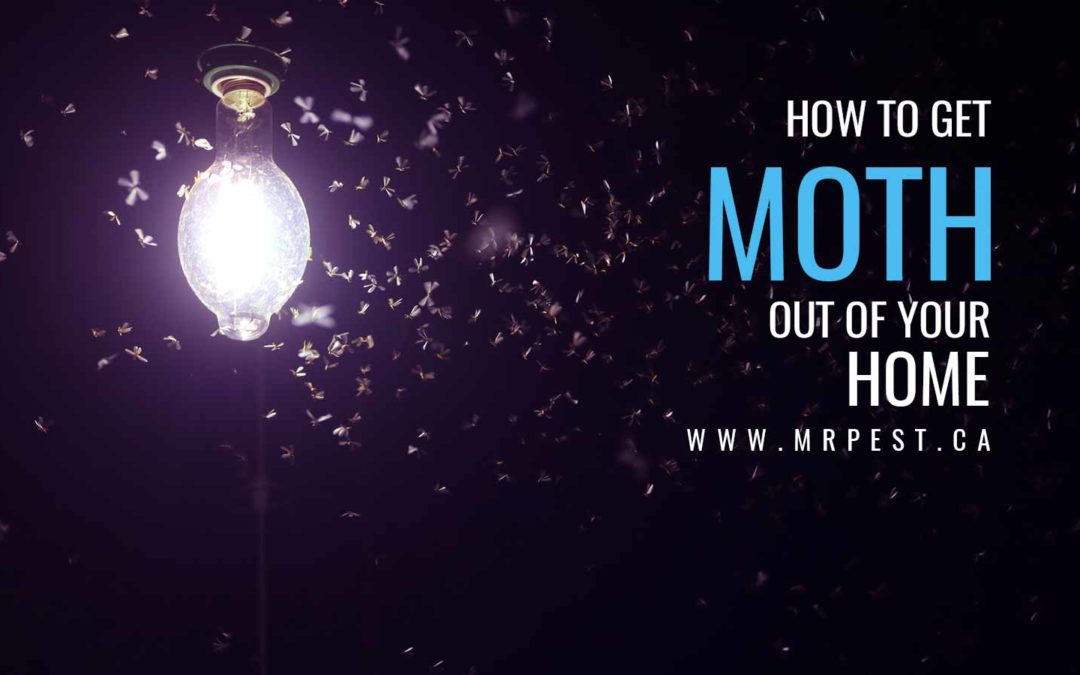While wintertime can provide a welcome relief from fruit fly friends buzzing around your kitchen, you may start to notice them being replaced by other winged companions flitting about your home: moths. While moths are harmless and quite easy to kill, it’s not so easy to get rid of them. If you see a few small moths in your space, it probably means there are many more preparing to hatch.
There are two types of moths that infest homes. Some lay eggs in food stored in your pantry, others in your clothes and carpets. There are some DIY treatments you can try, but a major infestation requires the help of a pest control professional.
Moth Identification
Your first step in controlling a moth situation is identifying which type of moth has invaded your home.
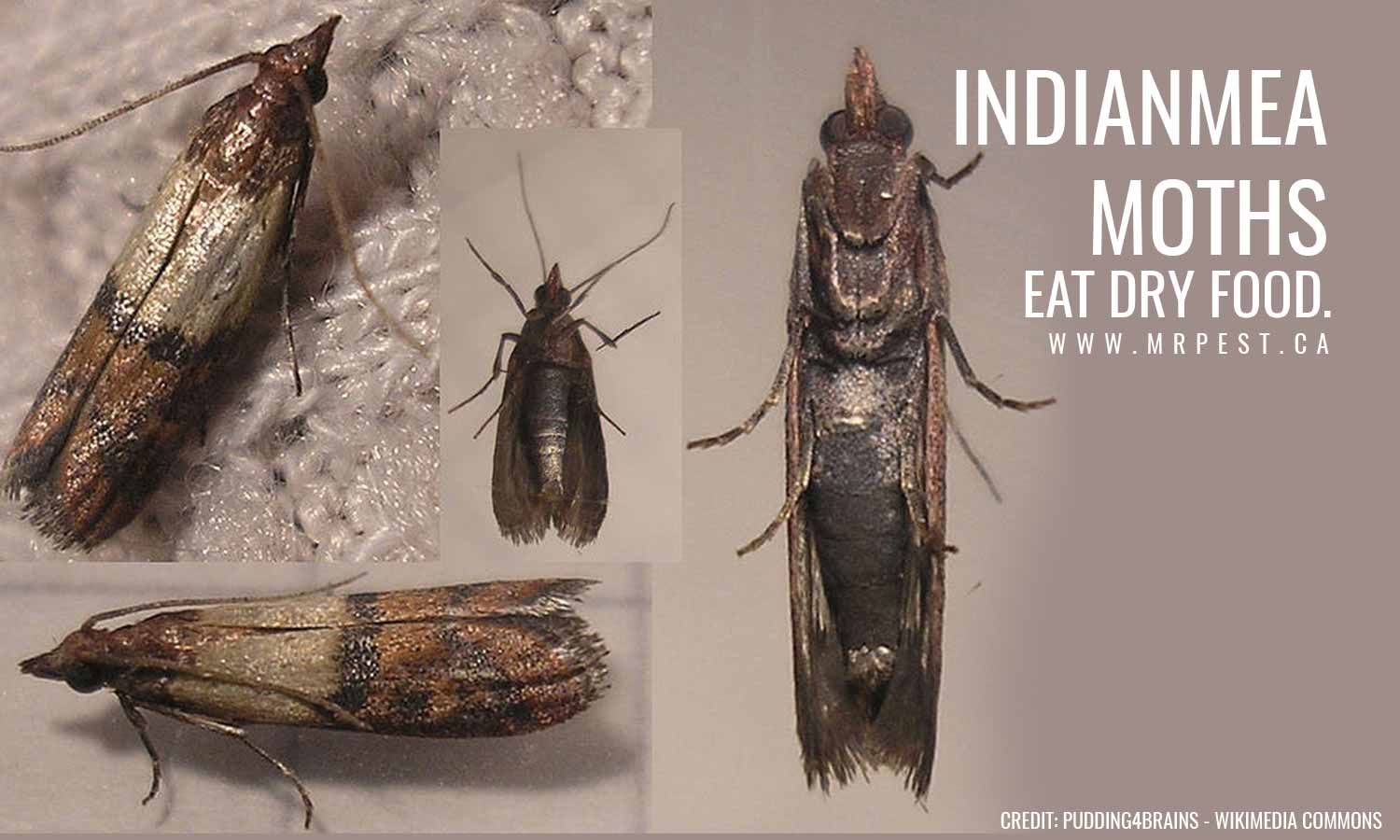
Indianmeal Moth (Plodia interpunctella)
Commonly known as a pantry moth, the Indianmeal moth infests your food. Here’s how to identify it:
- 14-17cm long
- Bald head
- Outer wings are yellow or cream-coloured at the base (and coppery red to dark grey at the tip)
- Larvae are white with no black dots
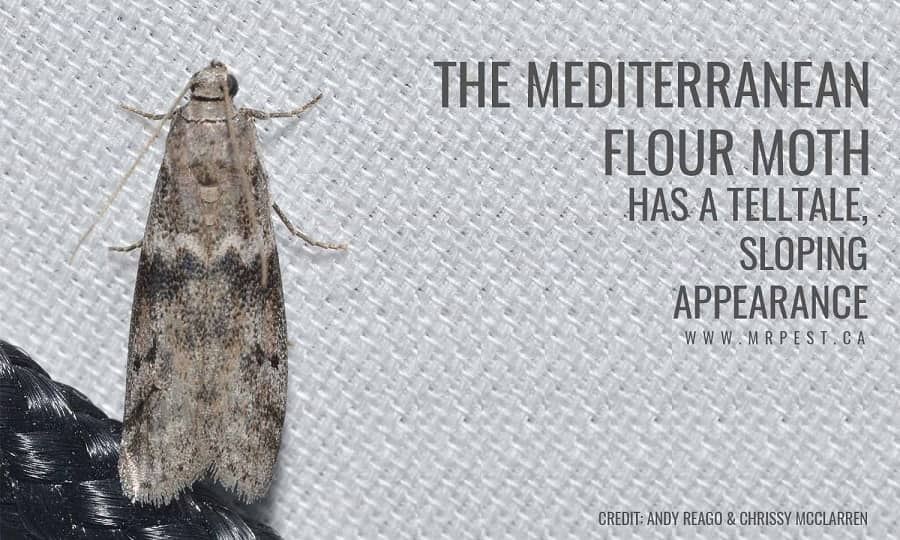
Mediterranean Flour Moth (Ephestia kuehniella)
Similar to the Indianmeal moth (but slightly less common) the Mediterranean flour moth is another type of pantry moth. Here’s how it differs from its cousin:
- 12-20 mm long
- Outer wings are grey with a dark zig-zag pattern
- Larvae are white with a dark head and dark spots at their base
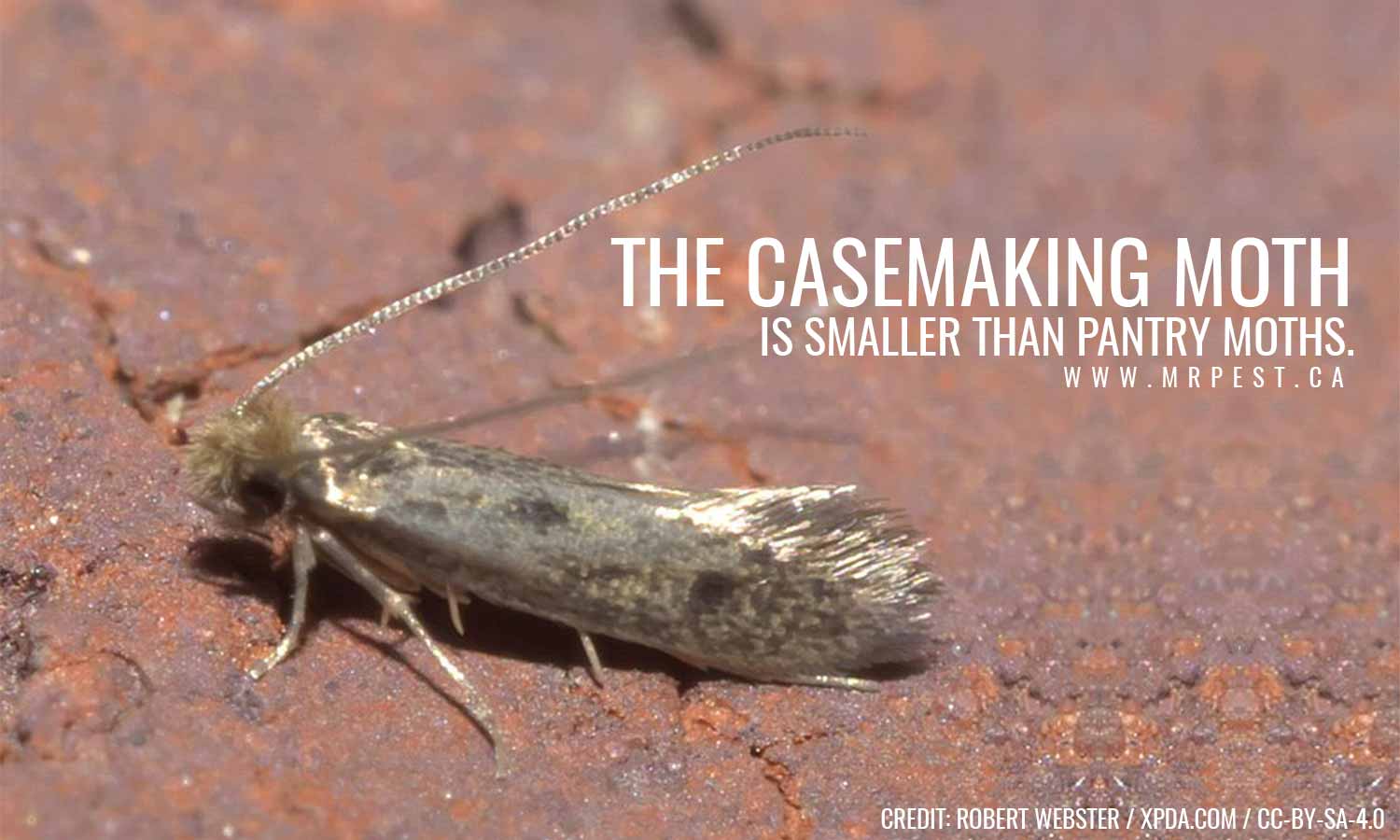
Casemaking Clothes Moth (Tinea pellionella)
These moths infest textiles from animal sources. They:
- Are 1 cm long
- Have silvery grey feathered wings
- Wear a furry tuft on their heads
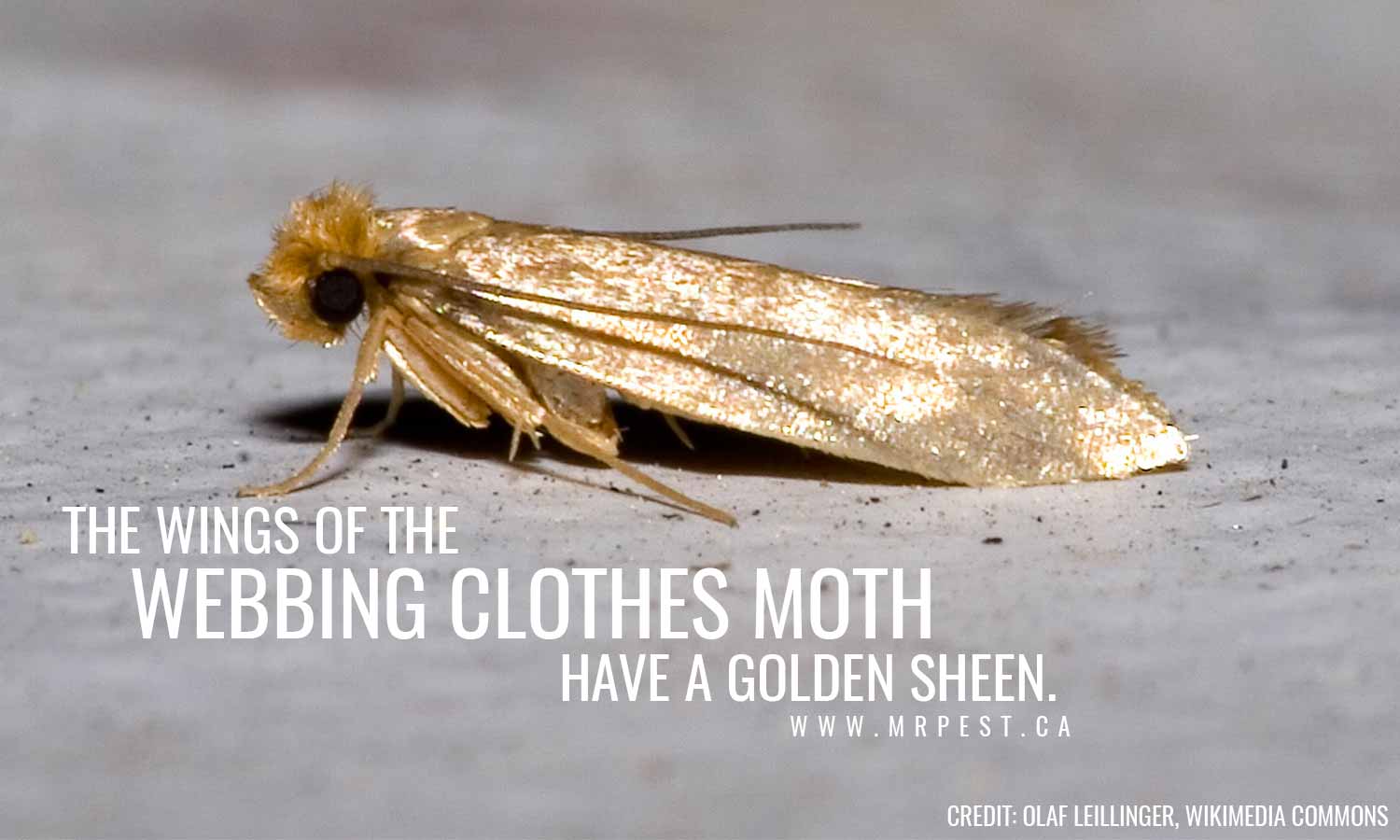
The webbing clothes moth is very similar to the casemaking clothes moth. It is also a textile-eating moth but has grey wings with a golden sheen and doesn’t spin a protective casing over itself until it enters the pupa stage.
Now that you can identify the moths in your home, the next step is to find their food source.
Pantry Moths
Pantry moths don’t eat your food. In fact, they don’t eat anything. Their only job is to reproduce. It’s their larvae that are chewing their way through your dried goods. They eat:
- Flour
- Rice
- Grains
- Dried fruit
- Dried flowers
- Nuts
- Cereal
- Cookies
- crackers
- Pet food and treats
Telltale Signs of Moths in Your Food
If you suspect you have pantry moths, check all your food cupboards carefully. Look for:
- A clumpy consistency in flour or other grains – the moths leave a sticky secretion when they lay eggs
- Silky webbing around the edges of containers (the remnants of the larvae’s pupae)
- Small, white worm-like larvae in the food
What to Do If You Find Pantry Moths
First of all, don’t panic. Moths and their larvae are harmless to humans. If you end up accidentally eating them, the only consequence will be you’ve ingested some unintended protein. Secondly, don’t blame yourself. Moths are not a sign of a dirty home. They almost always enter homes as larvae already present in purchased dry goods and are often impossible to detect.
Here’s what you can do:
- Throw out any visibly infested food – seal food tightly in garbage bags and remove from your home to prevent reinfestation.
- Empty food cupboards and vacuum all debris, paying special attention to corners where flour and grain may have spilled. Seal vacuum bags and remove from the home.
- Wash all cupboards with soap and water.
- If you suspect some food might have an infestation you can’t see, put it in the freezer for 24 hours to kill any eggs that may be present.
How to Prevent Infestation
Since moth eggs can enter your home undetected in food, protect your kitchen from any moths that might come your way again.
Here are some tips on how to keep your kitchen moth-free:
- Keep all dry goods in airtight glass or hard plastic containers. Moths can chew through cardboard and plastic wrappers.
- As a precaution, put any new dry foods you purchase in the freezer for 72 hours to kill eggs that might be present.
- You might even consider storing some dry food in your freezer if you have space.
- Check your pantry regularly for signs of larvae so that you can prevent them from multiplying.
- Set up pheromone-based glue traps which attract moths. These are harmless to humans and pets. While they won’t solve a moth problem, they will let you know quickly if the moths have reappeared.

Clothes Moths
If you identify clothes moths in your home, act quickly and thoroughly to prevent major damage. While throwing out a bag of oatmeal isn’t such a big deal, saying goodbye to a pile of your favourite woolen sweaters and leather bags is another story.
As with pantry moths, clothes moths don’t actually eat your stuff – their larvae do. Tthey feed on:
- Wool
- Felt
- Mohair
- Cashmere
- Leather
- Feathers
- Fur
- Textiles that are a blend of synthetic and animal-based fibres.
You might find these moths in your clothing, rugs, curtains, yarn, wall hangings, bags, hats, socks, and slippers. Moth larvae are especially attracted to dirty clothes with body oils or food residue. They also prefer dark places where items lie undisturbed for long periods of time.
Signs of a Clothes Moth Infestation
- Holes in the material, often with a crusty substance left by the larvae
- Silky tubes or cases on the material where moth larvae live or silk cocoons
- Worm-like larvae on the material
- Adult moths – they often crawl on your clothes or fly quickly into hiding when disturbed
What To Do
Again, don’t waste time panicking or feeling guilty. Clothes moths are harmless and can infest any area where susceptible textiles are stored. The most important thing is to save your valuables from further damage.
- Throw away all items damaged beyond repair. If a garment can’t be fixed, it’s better to get rid of it in case it still harbors stowaways.
- Wash all the items you want to keep. Use the hot water cycle if it won’t harm the fabric. You can also put items in the dryer on high heat if it won’t damage or felt them. Dry cleaning is the best option, when possible.
- Try placing items like leather, fur, and feathers in sealed plastic in the freezer (or outside if it’s frigid) for at least 72 hours.
- Put items outside in the sun for a few hours.
- Steam-clean carpets, rugs, and upholstery.
- Vacuum closets and wardrobes, especially the corners and crevices where moths and larvae hide. Again, to avoid reinfestation, be sure to discard vacuum bags into outdoor garbage bins as soon as possible.
How To Prevent Future Infestation
With some preparation and regular maintenance, you can keep clothes moths at bay and keep your beautiful textiles free from holes:
- Air out closets and clean them regularly. This is the best defense against clothes moths; they lurk in places that are dark and undisturbed.
- Store items that can stack in thick plastic compression bags or tightly sealed plastic bins. Transparent ones help you quickly identify what’s inside the containers, or you can label each bin.
- Store hanging items in clear garment bags – seal any seams or holes with tape.
What Not to Do
Some well-known moth solutions are ineffective or can be harmful. Here’s what to avoid:
- Mothballs and moth crystals – these are full of naphthalene, a known carcinogen, according to Health Canada. They are give off a noxious odour and are dangerous to children or pets.
- Cedar planks and lavender sachets are supposed to mask the scent of wool from moths, but they are only mildly effective.
- Cedar chests or closets can work well, but only if they seal properly.
Call A Professional
If you find moths in your rugs, wallpaper, or furniture stuffing, call an expert to remove all the moth larvae and eggs effectively. Also, damage to carpets and furs might be caused by carpet beetles. This is a serious infestation that must by addressed by pest control professionals.
While moths themselves aren’t inherently harmful, they can create other issues. The presence of these winged invaders might encourage a spider infestation (spiders like to feed on moths). If you suspect you have moths in your house, don’t delay. Take immediate action and call for help if your efforts don’t eradicate the problem.
For assistance with any of your pest control needs in Barrie or the surrounding areas, call Mr. Pest at 1-800-794-7378. We can handle carpet beetles and spiders, and any other insects that make your home life unpleasant.

